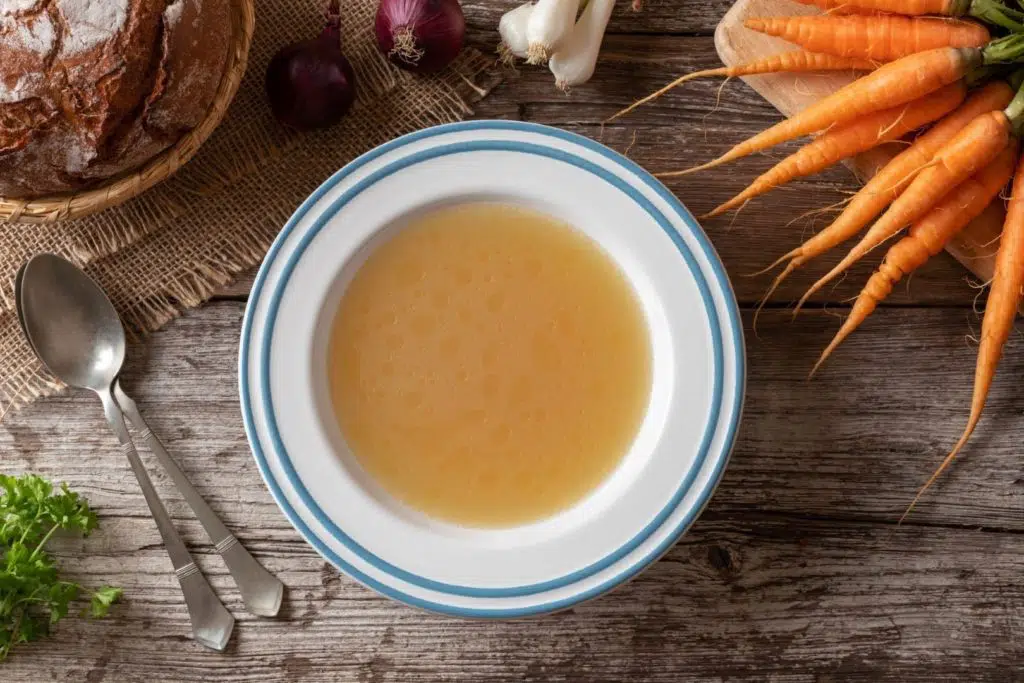Bone broth is a traditional remedy that works powerfully in cooperation with kefir to heal and restore your gut, which is the first step towards healing your skin.
The idea here is:
- Heal the lining of the gut with bone broth
- Re-populate the newly healed gut with the good bugs in kefir.
For more information on this powerful traditional remedy, I recommend The Bone Broth Secret: A Culinary Adventure in Health, Beauty, Longevity by Louise Hay and Heather Dane.
The decrease in traditional practices like “cooking with bones” happened at the same time that we’ve seen an epidemic-style increase in things like eczema – which is up more than 40% since 2005 alone! Coincidence? Maybe…or maybe just one more sign of the old traditional ways slipping by the wayside, leaving us less healthy than our grandparents were.
The magic in bone broth is that the tendons, joints and ligaments, when cooked down, supply collagen in a bioavailable form that’s easily accessed and used by your system. This is the stuff that heals the lining of the gut. It is also recommended by Dr. Natasha Campbell McBride in her GAPS (Gut and Psychology Syndrome) Diet.
Recipe for Bone Broth & Welsh Cawl – Serves 4
This recipe will both give you something delicious to serve for supper, and a supply of bone broth for you to re-heat and drink daily. We suggest that you have one mug of broth broth each day.
Ingredients:
1 chicken carcass, meat and bones
(Beef or lamb will also work. We find pork a bit too greasy for this purpose)
10 g (2 tsp) sea salt
5 whole black peppercorns
8 carrots
16 new potatoes
1 onion
1 swede
1 leek
Here’s how to make bone broth and cawl:
1. If you have roast on Sunday (which we nearly always do, on the farm) then you just chuck all the bones from the main carcass into a big saucepan.
2. If you’re starting from scratch, use one whole chicken, roasted. Remove the meat; it can be used for another entire supper. (Chicken pie, or chicken and gravy!) Put the carcass into the pan and top up with water until it’s about 2 inches from the top.
3. My stock pot is a whopping 20 L, but then I have a big family. Still, bone broth is such a brilliant thing that I’m going to encourage you to make extra and freeze a lot of it – so a large 10 L stock pot is a good thing to have on hand.
4. After a nice roast dinner on Sunday, on Monday morning the meat carcass leftovers go into the big stock pot and start simmering away.
5. Our bone broth simmers all day. The magic is bones + water + time. If you’re at work during the day, treat yourself to a slow cooker, and simmer it all day in that. Just put in enough water that the pan won’t go dry. The smell will uplift you when you come through the door at the end of the day, and give you strength to put together the rest of the supper!
6. After it’s simmered all day, sieve out the bones from the broth. I tip the broth into another pan, with a colander sitting in it.
7. This is where your bone broth comes out of the pot, to be stored for daily use. I tip off about half the broth into a separate container, which I store in the fridge for up to three days. I ladle some broth into a mug every morning and heat it up to drink separately, with a bit of sea salt and a squeeze of lemon.
8. If you’ve got more bone broth than you can get through in three days (don’t keep it in the fridge longer than that, as it’s the perfect environment for bacteria) you can also freeze it in large silicone ice-cube trays, made for freezing baby food, and pop out one at a time to thaw and reheat. Always reheat bone broth in a saucepan, not in a microwave. It’s just as fast, and the microwave distorts the molecules in your food – bad idea when you’re trying to improve your health! We don’t have a microwave on the farm… and don’t miss it. We don’t eat food that requires microwaving and I’m unhappy with the possibility of plastic leaching into our food. I find re-heating my own homemade leftovers is easily done on the stovetop or in the oven.
9. Put the remaining broth back onto the heat to continue simmering. Put the meat and bones to one side to allow the whole thing to cool enough to handle.
10. Put your veg into the simmering broth pan at this point. I use carrots, swede, new potatoes and onions. Use whatever vegetables you have on hand, and that your family likes.
11. If you’re starting from scratch, think two carrots and four new potatoes (chopped in half) per person that you’re feeding, plus one onion and one swede for the pot. All veg can be chopped quite roughly, in big pieces – this is a hearty peasant-style stew. The vegetables can simmer in the broth for about an hour.
12. Once the meat and bones have cooled enough to handle comfortably, pick any remaining meat off the bones. It should now come away from the bone easily. Add the meat back into the cawl 15 minutes before serving.
13. You can re-use bones for broth at least twice before discarding them – just pop them into the freezer until you’re ready to make cawl again.
14. In the meantime, it’s delicious cawl for supper! To give it the real traditional Welsh feel, chop up a leek and toss it in, along with the cooled meat, 15 minutes before you’re ready to serve. Season to taste with more sea salt and black pepper.














